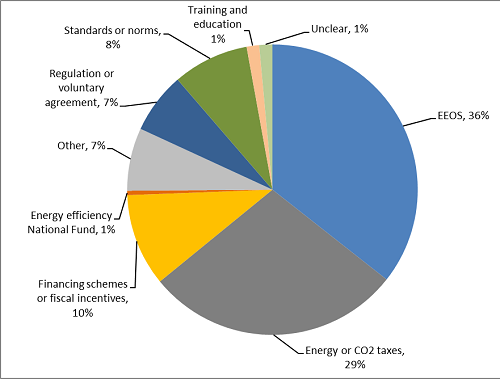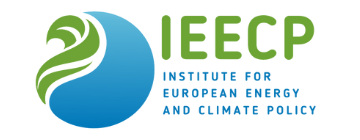Summary
Key questions
- What are the most important policy measures that deliver Article 7 EED energy savings target?
- What are the different approaches that MS have taken when implementing Article 8 of the EED?
Lead authors: Anna-Liisa Kaar; Rebecca Turner and Daniel Forster (Ricardo Energy & Environment)
Reviewers: Francis Altdorfer (ECONOTEC)
Energy Efficiency Directive
Directive 2012/27/EU of the European Parliament and the Council (the Energy Efficiency Directive (EED)) was set up to help the EU meet its objective of achieving a 20 % improvement in the EU’s energy efficiency by 2020. To this end, the EED established a set of binding measures through its different Articles, including provision for energy efficiency obligation schemes (Article 7), and energy audits and energy management systems (Article 8).
What is Article 7?
Article 7 requires Member States (MS) to establish policy measures to achieve new end-use energy savings each year from 1 January 2014 to 31 December 2020, amounting to 1.5 % of the baseline energy sales to final customers.
To meet their target, MS are required to establish an energy efficiency obligation scheme (EEOS). Alternatively, they are allowed to implement other policy measures such as energy and CO2 taxes, financing schemes and fiscal incentives, regulations or voluntary agreements, standards or norms, energy labelling schemes, training and education, and energy efficiency national fund, etc.
Who is affected by Article 7?
The obligation to implement the policy measures is aimed at MS – who is affected will depend on the national policies MS choose to implement.
Where MS choose to implement EEOS and place an obligation on designated obligated parties to achieve the energy savings, Article 7 requires that the obligated parties are selected based on objective and non-discriminatory criteria among energy distributors and/or retail energy sales companies operating in the territory of MS, and may include transport fuel distributors and transport fuel retailers.
Implementation requirements
Article 7, and the related Annex V, stipulate specific implementation requirements in relation to the policies to be used by MS and the associated energy savings. These include requirements associated with the methodologies for calculating the energy savings, and for monitoring and verifying the implemented measures. These requirements aim to ensure the credibility of the policy measures and the energy savings achieved.
MS were required to notify the European Commission of the policy measures that they expect to use to meet their Article 7 targets and how the measures meet the implementation requirements1.
National implementation of Article 7
Over 450 individual policy measures were notified by MS to deliver the Article 7 target. These are expected to deliver a cumulative energy saving of 250 million tonnes of oil equivalent (Mtoe) between 2014 and 2020.
Consistent with the focus of Article 7, the most important policy measure type in terms of expected energy savings is EEOS. Such schemes are expected to deliver 34 % of the total cumulative energy savings. So far, 16 MS have implemented EEOS (or are planning to), but only Bulgaria, Denmark, Luxembourg and Poland expect to implement an EEOS as their only policy measure (France is also expected to deliver 87 % of its savings through EEOS).
Remaining 12 MS expect to implement EEOS in combination with other policy measures and a further 12 MS expect to rely exclusively on other policy measures.
While there is a long history with EEOS in some MS (for example, Italy implemented EEOS in 2005, the UK in 1994, France in 2006, Denmark in 2006 and Belgium-Flanders in 2003 (expired in 2012)), several MS expect to newly introduce EEOS for Article 7 obligation purposes. Also Austria and Ireland have now replaced their voluntary schemes with a mandatory EEOS.
The other policy measures are expected to deliver a substantial part (66 %) of savings. Financing schemes and fiscal incentives are the second most important types of policy measure in terms of energy savings (contributing 19 % of the expected energy savings). Energy and CO2 taxes are less popular, and form part of the policy package in only eight MS. However, they are expected to deliver an important 14 % of energy savings. Sweden, for example, expects to implement energy and CO2 taxes as the only policy measure. The split of expected energy savings by policy measure types is shown in Figure 1. The data are based on initial plans of MS.
Figure 1: Expected energy savings by policy measure type

Source: DG ENERGY
It should be noted that as MS continue to implement new policy measures, or modify existing ones, the type of policy measure and savings delivered from individual policy measures may differ in practice. Therefore, it is appropriate to look at actual results achieved by MS.
Achieved results in 2014
According to the EED, MS need to report to the European Commission on an annual basis the energy savings achieved through policy measures notified in accordance with Article 7. The report is submitted in regards to the year before last – the results achieved in 2014 became available in 20162.
An assessment of the annual reports indicates that policy measures implemented by MS delivered 12 Mtoe of energy saving in 2014. This amount might change as some MS are still finalising their counting of savings for 2014. In some 2016 annual reports, no data for 2014 were provided. However, where linear delivery of savings from 2014 to 2020 is assumed, then MS are on track to achieve the savings requirement.
As expected, EEOS delivered the largest amount of savings (36 %), energy and CO2 taxes contributed 29 % of savings, and financing schemes and fiscal incentives contributed 10 % of savings. The breakdown of achieved savings per policy measure type is shown in Figure 2.
Figure 2: Realised energy savings in 2014 by policy measure type

Source: DG ENERGY
Ten MS implemented EEOS in 2014, including four that delivered their 2014 savings through EEOS only (Poland, France, Denmark and Bulgaria). Three MS delivered their 2014 savings through only financing schemes and fiscal incentives (Greece, Latvia and the Czech Republic). Energy and CO2 taxes also remain an important type of policy measure – a large share of savings was delivered in this way by Sweden (100 %), Estonia (97 %), Austria (76 %) and Germany (69 %). The distribution of savings between policy measure types might change in the future as MS implement new measures.
What is Article 8?
Article 8 of the EED relates to energy audits and energy management systems. It requires MS to promote and ensure the use of high-quality, cost-effective energy audits and energy management systems to all final customers. Under Article 8, MS must mandate that large enterprises undertake energy audits (or equivalent) at least every 4 years. They must also promote energy audits and energy management systems to small and medium sized enterprises (SMEs) – an SME is defined as an enterprise with fewer than 250 employees and a turnover of no more than €50 million or a balance sheet of no more than €43 million.
Who is affected by Article 8?
Large enterprises (that is, those that are not SMEs) had to conduct their first set of audits by 5 December 2015.
SMEs are not mandated to take any action, but MS are required to ensure that initiatives are in place to promote energy efficiency to SMEs.
Implementation requirements
MS have a degree of flexibility in how they implement Article 8, provided that their national transposition fulfils the EED’s minimum requirements.
Companies must calculate their total energy consumption, and audits must examine energy use across buildings, transport and industrial activities. As an alternative route for compliance with Article 8, MS can allow energy audits to be conducted in the framework of an energy management system. The implementation of this aspect varies between MS, but the most common route is certification to the ISO 50001 energy management system.
MS are not obligated to require companies to implement the measures identified through the audits.
National implementation for large enterprises
At the start of 2017, most MS had transposed Article 8 into their national legislation. Estonia and Lithuania are the exceptions – both have draft plans in place, but these have not yet been transposed.
In mandating large enterprises to conduct energy audits, most MS have used the EU’s definition of a non-SME to define the qualifying group of companies. However, a few have broadened their target group beyond the minimum requirements of the EED. For example, Bulgaria, Ireland, Romania and Italy have all set thresholds for energy consumption, above which companies are required to comply with auditing legislation. In some cases, MS have also chosen to exempt certain companies. For example, Denmark, Malta and Romania all exclude companies with an annual energy consumption below a minimum threshold. In Portugal, energy audits are only undertaken where they can be shown to be financially viable. In Denmark, companies participating in voluntary energy efficiency programmes are exempt. Some MS, such as the UK and Germany, have chosen to exempt public bodies.
There are a number of differences in the way that boundaries are defined for multinational companies. In some MS, companies must include all of their international operations when calculating their total energy consumption (for example, the UK, Finland, Denmark and Germany). However, others, such as Greece and Italy, specify that only energy consumed within national borders should be considered.
The EED specifies that audits must be representative of overall energy performance. In response to this, many MS have set minimum thresholds for the proportion of total energy use that must be covered by audits. In the UK and Germany this is 90 %, while Finland requires that 95 % of total energy use is covered.
Many MS have allowed a sampling approach to audits. This means that companies with a large number of similar sites must only audit a representative sample.
The majority of MS allow the use of in-house auditors. In line with the requirements of Article 8, these auditors must be independent of the process or activity that they are assessing.
The EED requires that MS set out penalties for non-compliance with Article 8. The penalties that have been introduced are largely financial and range in scale from €10 000 to €200 000. Most MS intend to carry out spot checks of company audits to enforce compliance.
The majority of MS require companies to proactively submit information on their energy audits to a regulating body. In Germany, Greece and the Netherlands, companies need only submit this information upon request.
Promotion of energy audits and management in SMEs
MS are required to encourage SMEs to undertake energy audits and to implement the associated recommendations. This involves addressing issues such as limited staffing and financial resources.
There are around 50 policy instruments in place across Europe that address energy efficiency in SMEs. The number and type of measures implemented varies widely across the MS.
Just under a third of MS have voluntary energy efficiency programmes that include SMEs. Companies signing up to these are incentivised to conduct energy audits.
Over half of MS have put in place financial measures that promote energy efficiency in SMEs. An example of this is the German SME Energy Consulting Programme, which provides funding support for energy audits and implementation of efficiency measures.
The provision of information-based support to SMEs is also common. This includes measures such as training, websites, helplines and knowledge-sharing platforms, which are often linked to funding support schemes.
Notes
- 1: Member States’ notifications are available at http://ec.europa.eu/energy/en/topics/energy-efficiency-directive/obligation-schemes-and-alternative-measures
- 2: 2016 annual reports are available at http://ec.europa.eu/energy/en/topics/energy-efficiency/energy-efficiency-directive/national-energy-efficiency-action-plans






